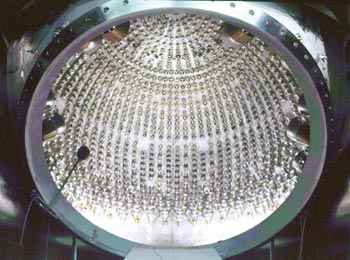

The assumption that coulomb barrier tunneling in stars is a two-body process is incorrect. Comparison of the results from the Kamiokande neutrino-electron scattering experiment with those from the chlorine experiment and with solar models shows that the explanation of the solar. The next generation of solar neutrino experiments are described. The present status of solar neutrino experiments is reviewed. (i) Oscillations of neutrinos which cross the mantle and the core of the Earth can be parametrically enhanced. The solar neutrino problem concerned a large discrepancy between the flux of solar neutrinos as predicted from the Sun's luminosity and as measured directly. Four oscillation solutions are discussed in the light of 708d Superkamiokande data: MSW, Just-So VO, VO with Energy-Independent Suppression (EIS) and Resonant-Spin-Flavor-Precession (RSFP). solution 2 eV# is only one order of mag-nitude smaller than the mass scale suggested by atmospheric neutrino oscillations. The electrons produced in charged-current reactions emit Cerenkov. The Solar Neutrino Problem - Miles Mathis was published by on.
THE SOLUTION TO THE SOLAR NEUTRINO PROBLEM WAS FULL
We perform a fit to the full data set corresponding to the 825-day Super-Kamiokande data sample as well as to Chlorine, GALLEX and SAGE experiments. solar neutrino problem, long-standing astrophysics problem in which the amount of observed neutrinos originating from the Sun was much less than expected. What was the solution to this problem? This Paper. What was the solution to this problem? The first bin is the average of the daytime rate of all of the. Predicted versus the observed zenith angle dependence of the total event rate above 6.5 MeV. Spin-flavor flip could, however, occur in the primordial magnetic field in the radiative zone. CiteSeerX - Document Details (Isaac Councill, Lee Giles, Pradeep Teregowda): The first KamLAND results are in a very good agreement with the predictions made on the basis of the solar neutrino data and the LMA realization of the MSW mechanism. A solar neutrino is a neutrino originating from nuclear fusion in the Sun's core, and is the most common type of neutrino passing through any source observed on Earth at any particular moment. Possible solutions to this problem are discussed. We analyze the current status of the solution to the solar neutrino problem based both on (a) nonstandard flavor-changing neutrino interactions (FCNI) and (b) nonuniversal flavor diagonal neutrino interactions (FDNI). Transcribed image text: Question 5 (1 point) The solar neutrino problem referred to the fact that, a few decades ago, fewer neutrinos were being detected from the Sun than predicted by our theory of nuclear fusion. Since 1991, when the FCNC solution was first considered, new solar neutrino data has become available.

(ii) Solution of the ν solar >-problem in schemes with three and more neutrinos which. INTRODUCTION The solution to the solar neutrino problem and new data from RHIC experiments were among the highlights of the 2002 fall meeting of the APS Division of Nuclear Physics, held October 9-12 at the … provided preliminary evidence a year ago for the neutrino-oscillation solution for the solar neutrino problem. Is Large Mixing Angle MSW the Solution of the Solar Neutrino Problems?, Phys. Leaders of these two projects would go on to receive the 2015 Nobel Prize in physics for discovering the solution to the solar neutrino problem: neutrino oscillations. The discrepancy was first observed in the mid-1960s and was resolved around 2002. Here cos N = cos(- ), where N is the nadir angle and is the zenith angle.


 0 kommentar(er)
0 kommentar(er)
